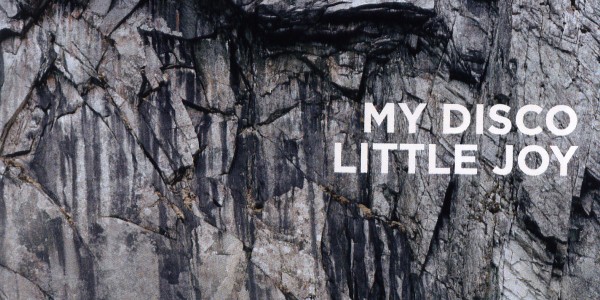At the heart of My Disco lies a series of paradoxes: discipline versus free-form exploration, light versus dark, intensity versus relaxation. I
At the heart of My Disco lies a series of paradoxes: discipline versus free-form exploration, light versus dark, intensity versus relaxation. It’s a dialectic formula that has come into its own with the recording of My Disco’s latest record, Little Joy . A tightly bound marriage of rhythmic intensity and pummelling industrial tones, Little Joy is the product of a band that know exactly where they’re going. And it’s no accident.
For the recording of their new album, Little Joy, My Disco took their love of contrast and paradox one step further, deciding to track the record with Steve Albini in Chicago, and mix the record in Sydney with Scott Horscroft. “We decided we wanted to track the album with Albini while we were on a tour of the US,” guitarist Ben Andrews explains. With the songs laid down, My Disco returned to Australia, and headed to Sydney where the sought the mixing talents and experience of Scott Horscroft. He offered My Disco an entirely different perspective than the notoriously raw and brusque Albini. The decision to have two different, and professionally distinct, people involved in the production of the record was entirely conscious, and well thought out. “We’d done the 12” [Young] with Scott, so we knew what it would be like working with him,” Andrews says. “It was totally planned.”
Andrews admits that Horscroft allowed My Disco the room to move that Albini may have struggled with. “The contrast between Albini and Scott was definitely important,” he agrees. “The initial tracks were all Albini’s sounds, but the way we approached the vocals, Steve would never have agreed to that.” Despite his pedigree working with Silverchair and The Presets, Horscroft was happy to let My Disco work in their own particular sandpit. “There’s a couple of songs where Liam’s voice acts as an instrument itself,” Andrews points out. “Scott understood that – and he understood that we weren’t Silverchair or The Presets.”
On previous records My Disco have been largely reliant on instrumentals, with the presence of vocal refrains a relatively rare occurrence. “I think we’ve definitely been more of an instrumental band,” Andrews admits. “But having said that, I don’t really like instrumental music all that much,” he chuckles. On Little Joy, Andrews says the band decided to place greater emphasis on the use of vocals as part of the band’s instrumental make-up. He explains that the vocals are intended to both illustrate and exaggerate a particular sound or rhythm the band is indulging on the record. “It’s a bit of both,” Andrews nods. “There’s definitely more lyrical and vocal content this time around. We love exploring songs, and the vocals on this record are an important part of that exploration.”
The interest in exploring vocal refrains and tones dovetailed with My Disco’s preference for a purposefully loose method of song construction and evolution. “We approached the record with a pretty relaxed attitude to each song. We went with the track with the best feel and vibe,” Andrews explains. “It was the same with Liam’s vocals – they were helped a lot by the analogue reverb we used to record the vocals.”
Essentially, at the root of a My Disco track lies a rhythm; from there, Andrews, his brother and bass player Liam and drummer Rohan Rebeiro explore the limits of the rhythm. “For the most part it’s a concept that we haven’t done before,” Andrews explains. “It often starts with a rhythm from Rohan. That said, we wrote the opening track with me strumming and the others just came in over the top. A few of the tracks were ready, but as we got closer to recording, we started to change things in the studio,” he adds. On the spectrum between rehearsal and spontaneity, My Disco’s preference lies closer to the latter. “We really didn’t want to rehearse the tracks too much,” Andrews admits. “We much prefer the improvised nature of the songs.”
While the songs on the record may have evolved naturally in the recording space, the track sequencing is nothing accidental. Andrews says My Disco’s overriding preference is to create an album product, not a simple aggregation of individual songs. “Little Joy is definitely an album,” he reasons. “We’d be disappointed if it just sounded like a bunch of songs. The guy who’s putting the record out overseas says that sequencing on an album is everything. So for this record we laboured over the sequencing in a way that we never would have if we were just playing the record live.”
Andrews says My Disco see Little Joy as a series of movements, spread out over three virtual sides to the record. The contrast between intense, almost frenetic jungle beats and slower, heavier tones wasn’t deliberate at the time, but does sit well with the band’s desire to mix and match. “We didn’t envisage that at the time,” he recalls. “But we now see the record in terms of double vinyl; with sides A, B and C. It’s like three songs over three single sides,” he chuckles.
My Disco’s tour diary has been full to the brim over recent years, with the band touring everywhere from the United States, eastern Europe, through to Indonesia and Malaysia. Touring offers the opportunity not only to see the sights and sounds of different countries and cultures, but to imbibe local music with a view to the band’s next round of writing and recording. “We got a couple of really cool Soviet-era records when we were in Russia,” Andrews remembers. “In Indonesia we went to this crazy Indonesia drum event – rhythmically we try and draw from those sorts of experiences.”
Little Joy is out now through Shock.







